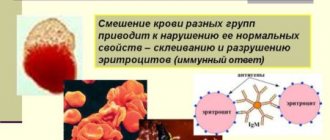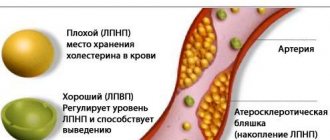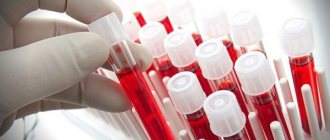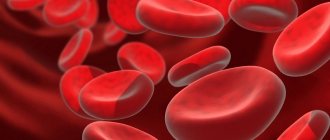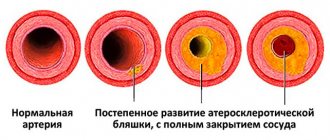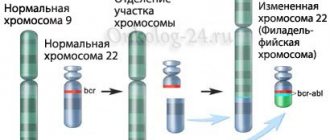Types of erythropenia
Mature erythrocytes (Er, RBC) are anucleate cells, 95% of their dry mass is hemoglobin. This compound is a respiratory pigment that delivers oxygen to body tissues. When the level of red blood cells in the blood is low, oxygen transport is disrupted, and a state of hypoxia develops in all organs of the body.
There is a decrease in red blood cells:
- absolute – Er are reduced as a result of disruption of their production or mass death;
- relative - the decrease is caused by an increase in the volume of circulating fluid, for example, with an increase in the daily volume of drink consumed, or an increase in the amount of circulating blood during pregnancy.
The causes of absolute erythropenia, leading to a low content of red blood cells in the blood, include:
- insufficient formation of cells of this population in the bone marrow;
- decreased production of the hormone erythropoietin by the kidneys, which stimulates hematopoiesis;
- accelerated destruction of red blood cells by macrophages in the spleen.
If low RBC is caused by decreased synthesis of this population in the bone marrow, then when the measurement is repeated, the test result will be repeated or the deviation will not exceed 10%. If there is a decrease in red blood cells due to their accelerated destruction (hemolysis) in the blood, the deviation of the test repeated a week later will exceed 10%.
The cause of low red blood cell counts in adults may be renal failure, which reduces the production of the hormone erythropoietin, which normally stimulates the maturation of the Er population, appearing in the blood in response to decreased oxygen levels.
Leukocytes in the blood
In addition to red blood cells, the bone marrow produces white blood cells called leukocytes. They perform a protective function in the body and represent the human immune system. At the slightest damage to the skin, internal organs or penetration of bacteria, leukocytes are the first to rush into battle and eliminate foreign microorganisms. In their composition, leukocytes have several groups of cells that also take part in the fight against foreign agents, but differ in their action - some secrete a special substance that kills bacteria, while others absorb the antigen and die along with them.
Such “dedication” of cells is justified, because in this way a person gets rid of the disease. Having died, the cell decomposes, but releases a substance that lures other leukocytes, which continue to fight the disease or foreign agent. As a result, when taking tests, any increase in leukocytes indicates pathological processes in the body.
Leukocytes can also be elevated when a new organ is transplanted; the human body does not accept a foreign object and initially tries to get rid of it. A very interesting fact is that when an animal senses danger, the number of leukocytes in its blood increases. The body thus prepares itself for the possible need to defend itself. This instinct is present in a person, when a person exposes himself to great physical activity, emotional experiences, and also experiences fear, the content of leukocytes in the body increases.
The norm of leukocytes in the blood is determined by the content of the optimal number of all constituent cells. The leukocyte formula includes indicators such as neutrophils - aimed at destroying bacterial microflora, their norm in the blood should be 55%; monocytes - perform the function of absorbing foreign agents that end up in the blood, the number of monocytes should be 5%; eosinophils - fight allergens and make up 2.5%.
Red blood cell norm
Red blood cell population norms for adult men and women by age, table.
| Age | Red blood cell count (10-12/l) | |
| in men | among women | |
| 20 — 30 | 4,2 – 5,6 | 3,5 – 5,0 |
| 30 — 39 | 4,2 – 5,6 | 3,5 – 5,0 |
| 40 — 49 | 4,0 – 5,6 | 3,6 – 5,1 |
| 50 — 59 | 3,9 – 5,6 | 3,6 – 5,1 |
| 60 — 65 | 3,9 – 5,3 | 3,5 – 5,2 |
| over 65 | 3,1 – 5,7 | 3,4 – 5,2 |
RBC norms vary by age and gender. If for a 40-year-old man the indicator 3.9 * 10-12/l is below normal and this means that he has few red blood cells in his blood, then for a woman of the same age this analysis result falls within the range of normal values.
What standards exist?
The MCV index is a factor that changes over the years; it is different for boys and girls. The maximum norm in children is noted in the initial days of life (from 90 to 140 fl).
By the end of the baby’s first year of development, the values range from 71 to 84 fl. At 5-10 years old, this index in a child fluctuates between 75-87 fl.
In adolescence (15-18 years), the norm in women rises: 78-98 µm3. In the period from adulthood to 45 years, the average volume of their red cells reaches 81-100 µm3.
In adolescence and youth, the norm for men is 79-95 µm3. From 18 years old - 80-99 µm3.
In an adult in mature years (45-65 years), regardless of gender, the values are 81-101 µm3.
Reasons for the decline in indicators
A decrease in the number of RBCs and the appearance of transformed cellular forms is observed as a result of:
- hereditary diseases;
- lack of protein in the diet or impaired absorption;
- violation of the intake or absorption of vitamin B12, folic acid;
- lack of hormones - thyroxine, corticosteroids, testosterone, growth hormone;
- deficiency of microelements zinc, copper, selenium;
- lack of iron intake or absorption.
Deficiency of vitamins B12 and B9 leads to the formation of large cells with a fragile, non-elastic membrane. Such a cell can carry oxygen, but its penetration into the smallest blood capillaries is difficult.
When passing through the spleen, deformed Er are destroyed first. The life of transformed cellular forms is reduced to 40–60 days from the usual lifespan of normal Er, which also leads to a decrease in the overall size of this population.
The reasons for the decrease in red blood cells in the blood are:
- acute bleeding;
- long-term chronic blood loss due to stomach ulcers, heavy menstruation in women;
- chronic infectious diseases;
- pregnancy, especially in the third trimester;
- alcoholism;
- treatment with analgesics, cytostatics, antibiotics, taking Corvalol, phenobarbital;
- dietary features – a large amount of legumes in the diet, a vegetarian diet;
- protein intoxication in kidney disease, caused by impaired excretion of protein from the body in the urine;
- the presence of autoantibodies to erythrocytes in plasma;
- multiple myeloma.
If antibodies to the receptors of one’s own red blood cells (autoantibodies) are present in the blood, then autoimmune hemolysis develops. The cause of autoimmune destruction of cell membranes can be a blood transfusion, the administration of a drug, due to which hemoglobin is released into the plasma, and in the analysis there are not only few red blood cells, hemoglobin is critically reduced, but also a sharp increase in bilirubin is observed.
Bilirubin appears as a result of hemoglobin metabolism. Yellow coloration of the skin develops when the concentration of bilirubin increases. If the blood test shows low red blood cells and is accompanied by jaundice, then the more pronounced its symptoms, the more likely this indicates massive hemolysis.
Causes of deviations and methods of their treatment
Causes of low average red blood cell volume
Factors that reduce the MCV rate include taking certain medications (antiviral, antimicrobial, sedatives), when the human body suffers from a lack of nutrients in internal organs and tissues. The main reasons for the decrease in values include:
- Lack of iron ions in the blood plasma.
- The presence of chronic or hereditary diseases.
- Presence of cancer.
- Lead poisoning.
- Hyperthyroidism.
In order to bring the level of average red blood cell volume back to normal, doctors individually prescribe medications containing iron. A strict diet is also necessary, in which the necessary vitamins and minerals will be introduced into the diet. Also, when dieting, it is very important to exclude from the diet foods that slow down the absorption of iron, such as cow's milk.
Causes of increased average red blood cell volume
MCV can be caused by methanol poisoning. The main reasons for the increase in values include:
- Lack of vitamin B12;
- Lack of folic acid;
- Development of macrocytic anemia;
- Pathology of the liver, bone marrow, renal failure;
- Hypothyroidism.
In order to lower the level of MCV and bring it back to normal, doctors prescribe medications that increase the level of vitamin B12. In some difficult cases, the appointment is prescribed on an individual basis.
Anemia is the cause of low RBC
The most common cause of erythropenia is anemia of various origins:
- iron deficiency;
- B12 is deficient;
- hemolytic;
- hypoplastic.
The condition of anemia can be caused by hereditary factors or acquired during life. With B12 deficiency anemia, red blood cells decrease to 1* 10-12/l.
And if in the blood of an adult the red blood cells are reduced to the specified value or are less than 1* 10-12/l, then this indicates a severe form of anemia and means that it is necessary to immediately eliminate the cause that caused this condition in the patient.
Signs of increased erythropenia, increasing the risk of severe anemia, are the appearance of:
- shortness of breath, feeling of lack of air with little physical exertion;
- floaters before eyes;
- coldness, pallor of the skin, with massive destruction of red blood cells, yellowing of the skin is possible;
- yellowing of the eye sclera;
- dizziness;
- headache;
- weaknesses;
- low blood pressure;
- weak, rapid pulse;
- heartache.
Decoding the result
If the average volume of erythrocytes is normal, the development of normocytic anemia is assumed, it occurs:
- hemolytic;
- aplastic;
- hemorrhagic;
- hepatic;
- endocrine.
High rate
When red cells are abundant, this indicates that the patient is developing macrocytic anemia.
The occurrence of this problem can be due to various reasons:
- lack of microelements (B12);
- lack of folic acid;
- megaloblastic anemia;
- presence of oncological education;
- hypothyroidism;
- malabsorption in the intestine;
- liver problems;
- myxedema;
- problems with the pancreas;
- diseased bone marrow with high leukocytosis;
- drug poisoning;
- alcohol toxicosis.
It has been noticed that the volume of red blood cells is slightly larger than usual in those who smoke and are treated with hormones.
In chronic drinkers, doctors also determine macrocytosis, while hemoglobin is within normal limits. This nuance allows for early diagnosis of alcoholism. But after 100 days of abstaining from alcohol, MCV returns to normal.
Frequent bleeding leads to a high index.
In some cases, macrocytosis occurs after long-term use of antidepressants. However, a clear connection with this fact has not been established.
The first signs of high erythrocytosis are blush on the face, redness of the skin on the body, headaches, and dizziness.
Low values
When the mcv value is low, this indicates the presence of microcytic anemia, which is a consequence of:
- chronic diseases and infections;
- iron deficiency;
- development of malignant tumors;
- lead poisoning;
- low hemoglobin levels;
- hereditary anemia;
- taking certain medications.
One of the reasons for the low index is a failure of water and electrolyte balance. This phenomenon is called hypertensive dehydration. During its development, the fluid space of the cells contracts due to a lack of water in the tissues. Dehydration occurs, caused by insufficient moisture saturation and lack of hypotonic fluid in the structures of the body.
MCV less than normal is recorded with hypochromic anemia, microcytosis, or decreased hemoglobin synthesis. The latter directly affects the shape and fullness of red cells
.
If there is less hemoglobin present than necessary, the red blood cells show less volume. Its synthesis also decreases when a person is sick with a genetic blood disease - thalassemia.
If someone experiences weakness, fatigue, tinnitus, absent-mindedness, severe pallor of the skin and memory impairment, he should consult a doctor. The number of red blood cells or their volume may have decreased.
Cell Variability
A person may show more than just an increase or decrease in MCV. In some cases, anisocytosis is diagnosed.
With this pathology, a microscope reveals many cells of different sizes, causing the blood to become too thick. The MCV indicator is closely related to others, such as , which characterizes the variability of cells in size.
Proper blood testing is very important. Making an erroneous diagnosis can lead to the most negative consequences. When in doubt, it is better to redo the analysis than to be treated incorrectly.
How to deal with poor performance?
In order to normalize the parameters of a biochemical blood test, a person must undergo appropriate therapy. You can increase low red blood cells in the blood by increasing the amount of iron-containing foods in your diet, these include:
The consumption of increased amounts of vitamin C and A is indicated; they can be purchased in pharmacies or consumed with food. If diet and giving up bad habits do not produce results, a blood transfusion is prescribed. In rare cases, a bone marrow transplant is necessary when the patient has stopped producing red blood cells. If the red blood cell count decreases too sharply, in some situations it is recommended to remove the spleen, since it is the spleen that destroys the red blood cells. To reduce the destruction processes, it is recommended to remove the organ.
An increased number of red blood cells will be treated depending on the disease that provoked it; detailed diagnosis is required. If no deviations are found, then a high-quality drinking regime will help reduce the number of red blood cells in the blood. Sometimes chlorinated water, which is often found in the pipelines of multi-story buildings, causes an increased number of red blood cells.
If low leukocytes occur, then a diet with an increased amount of folic acid is prescribed, as well as the drugs Pentoxyl, Leukogen, Methyluracil. A reduced number of leukocytes makes a person defenseless against many diseases. That is why all therapy will be aimed at strengthening the immune system. At home, a decoction of barley helps to increase the number of leukocytes.
As for elevated leukocytes, they should not be treated, since they are not the cause, but a consequence of the situation. The doctor is obliged to detect the pathological process that caused an increased level of leukocytes in the body and begin therapy for the diseased organ. There are a number of cases when there is an increased number of leukocytes after an illness or surgery; this is considered normal until a certain time. If the situation does not go away, then a hardware procedure is performed to purify the blood plasma from leukocytes.
It should be noted that it is quite difficult to make a diagnosis based on a blood test alone, so if you have poor results, do not be surprised if you are sent for additional diagnostics. Modern medicine has already learned to cope well with the imbalance of important enzymes in the blood, so it can easily normalize the indicators. It is very important to undergo a timely examination and seek help. A change in blood composition is the first sign of pathological processes in the body, and timely diagnosis will help protect the patient from many diseases.
Determining the level of red blood cells is important in diagnosing many diseases. For this, a blood test is performed.
Based on its results, conclusions are drawn about diagnosis and treatment. It is often found that the red blood cells in the blood are low. This pathological condition in medical terminology is called erythropenia.
What kind of disorder is this, what symptoms usually occur, whether there can be complications - this will be discussed in this article.
Reasons why red blood cells are low in a blood test
Supplying organs and all tissues with oxygen is a vital process for which blood cells such as red blood cells are responsible. They are also called red blood cells due to their color. An increase or decrease in red blood cells in the blood indicates a certain abnormality in the body. What low red blood cells mean and what their causes are will be discussed in this article.
- Functions and significance of red blood cells
- Causes of low red blood cells in the blood
Functions and significance of red blood cells
Almost everyone knows that hemoglobin, which is part of red blood cells and is responsible for their red color and the color of blood in general, is the main carrier of oxygen. But the functions of red blood cells are not limited to this. Few people know that:
- fats, proteins and some toxins can accumulate on red blood cells.
- The transport function of red blood cells is not limited to oxygen alone; it also transports amino acids, enzymes and other substances. This is also related to the previous point.
- Red blood cells normalize the acid-base balance of the environment, serving as a blood buffer system.
- Red blood cells are the most numerous blood cells among other forms.
- red blood cells “live” relatively short: 110-120 days and end their journey in the spleen.
- It is believed that red blood cells are low in the blood when a man has less than 4 million, and a woman has less than 3.9 million per microliter.
- Red blood cells can be classified according to size into 4 groups: normocytes, microcytes, macrocytes and megalocytes.
- analysis for the number of red blood cells is carried out manually by a laboratory assistant and then on a computer.
Causes of low red blood cells in the blood
If tissues and organs receive less oxygen due to low red blood cells in the blood, the patient feels this on himself, becomes weak, and quickly tires. But, of course, these symptoms cannot be the basis for starting treatment without confirmation by a blood test.
Red blood cells are low, what does this mean? This phenomenon has the medical term erythropenia or erythrocytopenia and indicates that there are fewer red blood cells in the blood than there should be in the normal state of the body.
Some of the causes of low levels of red blood cells in the blood include the following:
- Blood loss.
Severe trauma, damage to large vessels or organs can lead to anemia and a deficiency of red blood cells in the blood.
But hidden bleeding can also cause this effect. Moreover, hidden bleeding is more dangerous, because there is a risk of not noticing it in time.
In women, the level of red blood cells also decreases during menstruation, especially with heavy discharge. However, most often this deviation fits the description of the norm and does not require special treatment.
- Poor production of red blood cells.
Red blood cells are lower than normal if the body does not get enough vitamin B12, iron or folic acid. But even with normal nutrition, some substances may not be absorbed. This is observed in diseases of the gastrointestinal tract.
- Pregnancy.
During this period, a woman’s body retains more water than usual, thereby thinning the blood and reducing its viscosity. That is why if red blood cells are slightly reduced during pregnancy, this is normal. But again, only a doctor will help you decide on the concept of “a little”; low red blood cells during pregnancy up to 3 million are usually considered acceptable.
What is the norm of red blood cells for women, see here.
For more serious disorders, vitamins and iron complexes should be prescribed.
- Hereditary abnormalities of blood composition.
There is a genetically determined change in the number, shape and size of red blood cells. At the same time, red blood cells often also do not live out their allotted time, being destroyed ahead of time.
- Premature destruction of red blood cells.
Anemia (anemia) is associated with low red blood cells, the cause of which is the accelerated destruction of these cells.
- Taking certain medications.
For example, phenobarbital, which is a component of Corvalol, provokes a decrease in the number of red blood cells in the blood. Chemotherapy has the same effect, only greatly enhanced.
- Infectious diseases.
Acute infections such as diphtheria, whooping cough, etc. – another reason for low red blood cells. Their reduction in this case occurs in two directions: due to the effect of toxins on the bone marrow and due to the increased destruction of red blood cells.
- Oncological diseases.
The formation of tumors in the bone marrow entails a clear decrease in the concentration of red blood cells in the blood. Low hemoglobin also indicates the development of cancer.
- Autoimmune diseases.
Regular connective tissue diseases, in which the body itself produces cells that oppose normal bodies (including red blood cells).
- Diseases of the endocrine system, urinary tract, liver, liver.
- Lack of folic acid, iron and vitamin B.
Diet, unhealthy eating and avoiding meat also fall into this category of reasons.
Treatment of low red blood cells during pregnancy or any disease is impossible without establishing the exact cause of this disorder. This is why self-medication and prescribing vitamins for yourself is not a good idea.
Remember that if red blood cells are low in your blood for no apparent natural reason (pregnancy, blood loss, for example, after donation), this is a serious factor to consult a doctor for examination. Blood and its regular analysis help us detect the disease in its embryonic stage and do everything to prevent it from developing into a more complex form.
Be healthy!
Diagnosis of anemia
To diagnose anemia, a complete blood count is often sufficient. But sometimes, to identify its cause, additional studies are necessary, which include the average volume and width of distribution of red blood cells, hemoglobin electrophoresis, the number of reticulocytes, and determination of the level of iron in the blood.
Because anemia can have many causes, the patient may need to be tested for kidney or liver failure, lead poisoning, or vitamin deficiencies. If your doctor believes internal bleeding is causing the low red blood cells, he may order a stool occult blood test and endoscopy. In addition, a bone marrow examination may be necessary, which requires a biopsy.
Causes of low leukocytes in the blood
Leukocytes are blood cells that protect the body from the activity of bacteria, viruses, fungi and other microorganisms. They provide resistance to various diseases, so their reduction or absence is dangerous. In cases where there is a shortage, absence, or concentration of blood cells that exceeds the norm, you need to undergo an examination and determine the cause.
Physiological reasons
Physiological leukopenia is rarely observed. The disorder occurs in no more than 10% of Europeans who do not have functional or organic bone marrow disease. In this condition, the values do not fall below 2*109/l.
A reduced number of leukocytes in the blood is manifested by:
- during night sleep due to activation of the vagus nerve;
- after visiting a bathhouse, sauna, or a long stay in a hot bath;
- under stress.
The main reason for the deviation is the migration of formed components to other zones of the vascular bed.
Causes of low red blood cell count.
The content of red blood cells in the blood is one of the basic indicators of the body’s condition, which is required for any examination.
A general blood test contains information about the number of red blood cells and their sedimentation rate. These numbers are important for the doctor; they will be the reason for prescribing an additional examination if there is a deviation from the norm.
Expert opinion
Kovaleva Elena Anatolyevna
Doctor-Laboratory Assistant. 14 years of experience in clinical diagnostic services.
A low red blood cell count may explain constant fatigue, lethargy, headaches, and ailments with subtle symptoms of any disease.
Red blood cells in the blood are low - what does this mean?
A low content of red blood cells detected during a blood test means that the number of cells responsible for many processes in the body, including the saturation of tissues and organs with oxygen, has decreased significantly due to pathological processes in the body.
An absolute decrease in the number of red blood cells indicates disturbances in the functioning of the bone marrow, where these blood particles are produced. A relative decrease can be caused by drinking too much, infusion therapy (intravenous fluid), and some infectious diseases.
But the reason for both the absolute and relative decline must be sought. After all, even a short-term decrease in red cells can cause a lot of trouble. Having ceased to receive sufficient oxygen, the body begins to react to this:
- lethargy, feeling tired;
- decreased blood pressure with increased heart rate;
- lethargy, with a sharp decrease – loss of consciousness.
External signs include pale skin, mucous membranes may have a bluish tint, as in cyanosis, the skin is moist and cold.
The doctor, prescribing additional studies, records disturbances in the supply of oxygen and the removal of carbon dioxide, possible vitamin deficiencies, a decrease in the protective functions of the body, and blood thinning. In the future, the results will help doctors make the correct diagnosis.
Red blood cell norm
The norm of red blood cells in the blood is different for people of different ages and gender. In 1 cubic milliliter of blood there should be an average of 4-5 million of them. But this is a very average indicator for an adult.
In newborns the norm is 4 – 6.6X10 12 /l, in the first two weeks of life the amount decreases to 3.6 – 6.2X10 12 /l, at 1 year the norm is 3.7 – 4.4, at 3 years – 4 – 4.5 X10 12 /l. The latter indicator becomes the norm for children before they reach 12 years of age.
Normal for girls from 12 to 19 years old is 3.5 - 5 X 1012 / l, for boys - 3.9 X 5.6 X 1012 / l.
Red blood cells in the blood of women should be from 3.5 to 5.2 X1012/l, in men - 4.2 - 5.3 X1012/l.
This indicator decreases in older people, the norm for them is 4 - 4.2, as well as in pregnant women, whose blood volume increases, but the number of red blood cells remains unchanged.
Lower red blood cell counts are considered erythropenia, the cause of which must be determined very quickly.
Reduced concentration in a child
Low red blood cells in children are most often associated with a lack of iron, as well as folic acid and vitamin B12. Anemia is caused by an insufficient amount of these substances supplied with food, due to which hemoglobin, important for tissues, is synthesized. A genetically determined disorder in the process of hemoglobin formation can also disrupt the normal composition of the blood.
But a low number of red blood cells can also be associated with the destruction of blood cells due to prolonged infection or inflammation, chronic kidney disease, blood loss during surgery or injury.
Expert opinion
Kovaleva Elena Anatolyevna
Doctor-Laboratory Assistant. 14 years of experience in clinical diagnostic services.
Leukemia is one of the most serious diagnoses that a doctor can make in advance by detecting only low red blood cells in a child’s blood . But doctors conduct a lot of additional research before the words about oncology are heard.
And if it is nevertheless confirmed, early diagnosis and treatment save almost all young patients.
A low number of red blood cells in young patients should cause serious medical attention also because this may indicate a large loss of blood as a result of bleeding, including internal bleeding. And children are not always able or willing to talk about bruises, falls, fights with peers, which can result in damage to large vessels, the spleen, and other organs. urgent medical intervention can save the child .
Decreased red blood cell count in adults
A significant decrease in red blood cells in adults can be caused both by taking certain medications and by diseases.
genetically determined low number of red blood cells can sometimes be inherited. With such pathologies, red blood cells are not only not produced in sufficient quantities, but also die ahead of schedule.
Blood loss can occur as a result of injury, surgery, or trauma to blood vessels or organs. Often, a constantly low number of these cells indicates an open ulcer in the gastrointestinal tract and chronic internal bleeding. In women, a change in the number of red blood cells can be observed during heavy menstruation, after which the blood quickly returns to normal.
Infections and parasites contribute to the rapid destruction of red cells, which the bone marrow simply does not have time to produce in sufficient quantities. Severe poisoning, including lead, poisons, and alcohol, quickly destroys red blood cells
Iron deficiency anemia is recorded not only in children, but also in adults. The cause may be strict diets, poor nutrition, fasting, vegetarianism.
Liver cirrhosis, metabolic disorders, and kidney disease are accompanied by erythropenia.
Neoplasms in the bone marrow , malignant tumors and metastases in it disrupt the body’s ability to produce full-fledged red blood cells in sufficient quantities, which is why doctors conduct serious research to rule out oncology.
The number of red blood cells can also be affected by some autoimmune diseases , as a result of which the body's cells responsible for immunity destroy healthy cells. These include red blood cells. Among such diseases are leukemia, lupus, rheumatoid arthritis, mycoplasmosis, type I diabetes, which cause secondary anemia . Idiopathic, that is, that appears without reason, primary anemia is eliminated with the help of glucocorticosteroids, prednisone, secondary anemia is eliminated by transfusion of plasma or whole blood, purifying it from antibodies. Large doses of folic acid are administered intramuscularly to stimulate the production of red blood cells.
Expert opinion
Kovaleva Elena Anatolyevna
Doctor-Laboratory Assistant. 14 years of experience in clinical diagnostic services.
A decrease in the number of red cells also occurs with the use of certain medications that have a diuretic effect , as well as phenobarbital, and long-term use of antibiotics.
There are a number of diseases that cause a decrease in the number of red blood cells: adenoma in men, glomerulonephritis, whooping cough, hemoglobinopathy, ovalocytosis, kidney stones and others.
